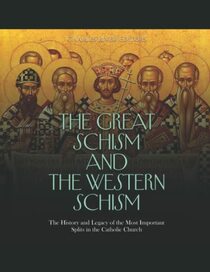Charles Rivers explains how the Catholic Church split along political lines (The Roman Empire with Rome at its head and The Byzantine Empire with Constantinople as the capital). Keeping the operation running smoothly was challenging with so much landmass and people in the Roman Empire. Thus, two capitals were initiated. It worked for a time, politically and religiously. However, asking Rome's opinion of all religious questions became cumbersome.
A fundamental issue was that the western part of the empire used Latin for communication while the eastern empire used Greek. In the West, the papal authority eventually oversaw the emperors and kings of the areas. However, in the East, the Church only dealt with religious issues, not politics. As Constantinople was a much-richer area, they became less willing to be subordinate to Rome.
But the cracks started to emerge when Pope Nicholas I interfered with establishing a Patriarch of Constantinople (leader of the Eastern Church) in the 820s (CE). It was called the Photian Schism and lasted for about 4 years. In the Nicene Creed, the Roman Church recognized that the Holy Spirit comes from God, the Father, and Jesus, the Son. In the Eastern Church, they believed and believe that the Holy Spirit comes from God, the Father. Period.
Interestingly, over the years, the Eastern Church looked to transition back to earlier forms of their religion, while the Western Church looked to reform their practices (adding new ways of doing things). This made the two churches less able to meet in the middle. But Humbert's (he was a leader representing the Pope of Rome) ex-communication of the members of the Eastern Church was the final straw. This book points out that the schism was based on the intolerance of each other's cultural values. They saw their cultural values as 'the only true ones."
Fortunately, this book addressed the issue of the Crusades and their effects on the Schism. It only made things worse. The author also introduced the papacy of John the 23rd (the one in the 1960s, not the antipope) as a man trying to reduce the hostilities between the two most significant sections of the Christian Church.
This book deeply delves into the establishment and downfall of the Avignon Papacy and the antipopes. The explanation was clear and engaging.
A fundamental issue was that the western part of the empire used Latin for communication while the eastern empire used Greek. In the West, the papal authority eventually oversaw the emperors and kings of the areas. However, in the East, the Church only dealt with religious issues, not politics. As Constantinople was a much-richer area, they became less willing to be subordinate to Rome.
But the cracks started to emerge when Pope Nicholas I interfered with establishing a Patriarch of Constantinople (leader of the Eastern Church) in the 820s (CE). It was called the Photian Schism and lasted for about 4 years. In the Nicene Creed, the Roman Church recognized that the Holy Spirit comes from God, the Father, and Jesus, the Son. In the Eastern Church, they believed and believe that the Holy Spirit comes from God, the Father. Period.
Interestingly, over the years, the Eastern Church looked to transition back to earlier forms of their religion, while the Western Church looked to reform their practices (adding new ways of doing things). This made the two churches less able to meet in the middle. But Humbert's (he was a leader representing the Pope of Rome) ex-communication of the members of the Eastern Church was the final straw. This book points out that the schism was based on the intolerance of each other's cultural values. They saw their cultural values as 'the only true ones."
Fortunately, this book addressed the issue of the Crusades and their effects on the Schism. It only made things worse. The author also introduced the papacy of John the 23rd (the one in the 1960s, not the antipope) as a man trying to reduce the hostilities between the two most significant sections of the Christian Church.
This book deeply delves into the establishment and downfall of the Avignon Papacy and the antipopes. The explanation was clear and engaging.




